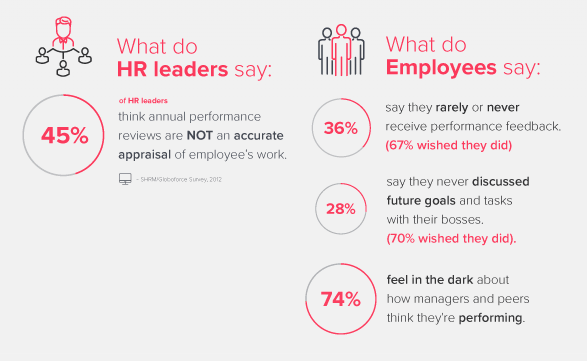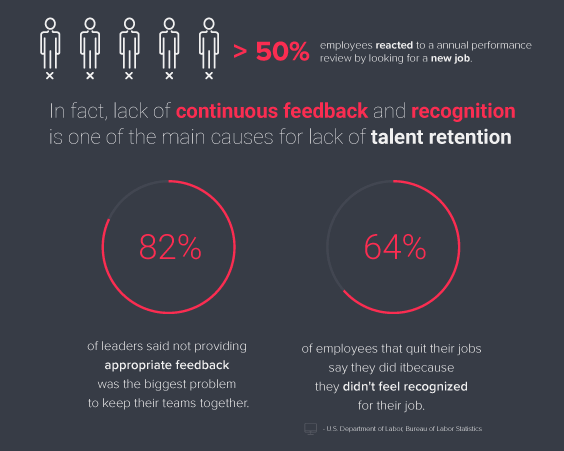A feedback culture doesn’t necessarily do away with formalized feedback mechanisms that remain popular in many organizations, but it does seek to address some of the problems. Businesses face ongoing problems including performance reviews and hyper-structured feedback processes that still remain in place.
For example, constrained and regimented feedback forms don’t encourage employees to be honest in their appraisal of their superiors. This is because junior staff is unused to being asked for their honest opinion in such a way when the feedback process is pigeonholed into annual reviews and anonymous surveys.
A genuine feedback culture encourages every employee, no matter their seniority, to voice their opinion. When you foster a feedback culture, staff will feel they have the right to give feedback to any other person in the organization. Ultimately, this leads to healthier dialogue and more productive exchanges all around.
What’s more, many contemporary employment models make rigid feedback processes less efficient than they are in the context of traditional corporate organizations.
Agile teams, remote working, and flexible contracts such as those we see in performance marketing can make it awkward for people to give honest criticism unless a feedback culture is in place. If you don’t know the performance marketing definition, it’s a type of marketing in which marketers are paid on the basis of measurable results, rather than a flat rate.
In this post, we’ll cover five actionable tips to help you foster a feedback culture in your company so that you can improve employee productivity. Here’s how.
1. Encourage Spontaneous Positive Feedback
If you really want to cultivate a work culture in which people feel comfortable giving each other the feedback everybody needs to grow professionally, you should encourage employees to give each other spontaneous, unsolicited positive feedback on top of your company’ team building activities.
When a new staff member starts, that is a great opportunity to explain the importance of feedback when it comes to boosting productivity. Energize employees to congratulate each other on their projects, or any time they see good work being done.
If you’re a manager or company director, always lead by example in this respect. Make sure you are seen to be rewarding people for finding solutions to problems and innovating. Some employees are naturally less risk-taking. It’s not that these people don’t have good ideas, it’s just that they’re more likely to need a little encouragement to fulfill their potential.
Without being overly pushy, make a note of less vocal workers and ask them for their opinions in private. Remember that some people find it difficult to speak their minds in large groups or meetings. Therefore to facilitate open communication in the workplace, you need a blend of group, one-to-one conversations, and feedback sessions.
2.Distinguish Between Negative and Constructive Criticism
When giving feedback, many people shy away from making comments that could be conceived as critical. This is natural as no one wants to risk offending their colleagues or be perceived as overly strong-headed.
Yet placing the emphasis only on positive feedback can mean you miss opportunities to improve. The solution is not to give negative criticism. Understanding the difference between negative and constructive criticism is key to being able to comment on areas for improvement without it being interpreted as a personal attack.
Negative criticism means voicing an objection to something with the sole purpose of showing that it’s wrong. Constructive criticism on the other hand is solution-oriented. The purpose of constructive criticism is to show that a task or workflow may be more optimally performed with an alternative approach.
As well as facilitating a greater level of civil discourse for all involved, incorporating constructive criticism into your work culture while removing negative criticism can help you to avoid overworking your employees. That’s because negative criticism can lead people to double-down on their workload without making changes to the process itself.
Ultimately, the point of feedback is rarely ever to say “work harder”, but usually to say “this is how you can work more efficiently to produce better results”. The first statement is an example of the kind of negative criticism you should avoid; the second a constructive statement.
3. Make Feedback Routine
Although a feedback culture doesn’t allot specific times and places for eliciting feedback, to encourage the kind of work environment in which people organically give feedback in any situation where it is appropriate, you may still need to implement some routine feedback sessions.
Daily team meetings are a great platform from which to initiate feedback conversations among colleagues that many companies already have in place. They can be as short as a few minutes and help team leaders to keep track of their colleagues’ workloads and progress.
If a team leader finds a certain colleague falling behind or struggling, this is an opportunity for a two-way feedback loop. The team leader will be able to give feedback as to what their concern is. In turn, the employee who is having difficulty is given a chance to explain how other team members could better support them.
Even in a remote work environment, for example, a remote call center, modern communication technology allows teams to have daily briefing meetings and regular feedback sessions.
4. Implement Continuous Feedback Mechanisms
In a feedback culture, not only is feedback shared freely and openly but it is also given continuously, on a rolling basis.
Continuous feedback is important when it comes to projects with multiple stakeholders. If you work with multiple clients, contractors, freelancers, or a job that brings together many people from different organizations, they’ll have different agendas. In these situations, having continuous feedback mechanisms in place prevents conflicts of interest and ensures the requirements of all parties are aligned.
When business partners are allowed to continuously provide each other feedback, it creates a cycle of improvement that helps projects to evolve more efficiently, benefiting everyone.
This is exactly the approach applied by b2b SEO companies, which frequently offer an open-ended service that allows clients dynamically to adjust their goals according to the feedback they receive from the SEO specialist.
Continuous feedback minimizes the chance that areas of poor performance will not be attended to. If feedback is only made at the end of project cycles, opportunities to improve may be missed. Make sure the whole team knows that if they see something they think could be improved, or observe someone doing something well, to mention at the time rather than waiting.
As workforces evolve, continuous feedback will also grow. This is in part due to millennials wanting feedback 50% more often than older employees.
The trend for a preference for more frequent feedback is even more pronounced with Generation Z. A 2018 survey by the Center for Generational Kinetics found that over 65% of Gen Z employees say they need feedback from their supervisor at least every few weeks in order to stay at their job. More striking still, one in five requires feedback daily or several times each day in order to stay with an employer.
5. Make Use of Multiple Feedback Channels
As already mentioned, even remote teams can give each other feedback thanks to the different types of communication channels available to workers today. But you don’t need to be working remotely to make the most of multiple means of communication.
Even in-location staff can benefit from the full range of communication channels to give each other feedback. This means that colleagues get the chance to pass on advice, encouragement, or constructive criticism even if it occurs to them after a direct conversation has happened.
When you work with the same colleagues over a period of time, you soon learn via which channels they prefer to communicate. Some people are great at responding to emails but lack confidence in person. Others prefer the more informal, more mobile style of conversation that chat apps and SMS messaging afford people.
The more channels there are available for giving feedback, the more likely people are to do it. Normalize giving feedback via whichever communication tools are used by your workforce - whether it’s sending a “well done” email or using the company VoIP phone number to offer a suggestion for improvement.
Conclusion
With the right attitudes and protocols in place, feedback needn’t be a chore or a mere box-ticking exercise. When the process of giving and receiving feedback is fully incorporated into a company’s culture, it can boost employee productivity, enhance accountability, and drive innovation.
By following the five tips discussed here you should be well on your way to fostering a feedback culture among your company’s employees. Just remember that feedback isn’t a quick fix or end in itself. It is an ongoing process that requires the input of all staff members - from the newest, most junior employees, right the way up to the executive leadership.
Instantly improve your employee feedback loops.

Written by Grace Lau
Grace Lau is the Director of Growth Content at Dialpad, an AI-powered cloud communication platform for better and easier team collaboration. She has over 10 years of experience in content writing and strategy. Currently, she is responsible for leading branded and editorial content strategies, partnering with SEO, Artificial Intelligence Customer Service, and Ops teams to build and nurture content.
















